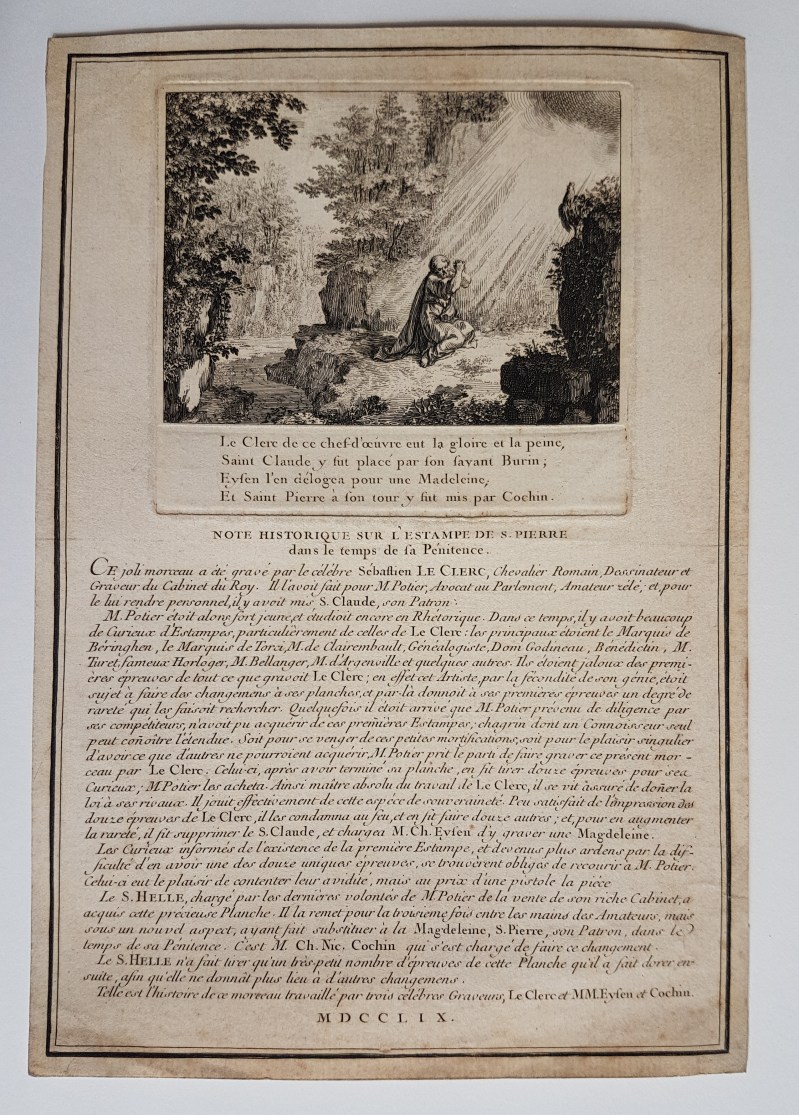Sébastien LECLERC: Saint Claude priant dans la solitude
Price: € 2500
[Saint Claude praying in the wilderness]
Etching, 103 x 113 mm. IFF 18, 6th state/9.
Fine impression printed on laid paper. In good condition. Sheet: 246 x 168 mm.
Impression of the 6th state (of 9), with Le Clere corrected to Le Clerc in the quatrain beginning Le Clerc de ce chef-d'œuvre, before that quatrain was replaced by the one beginning Saint Claude par Le Clere.
The quatrain was printed with the help of an additional plate in the lower part of the print, on a sheet bearing a NOTE HISTORIQUE SUR L’ESTAMPE DE S. PIERRE dans le temps de sa Pénitence (Historical Notice on the print of Saint Peter during the time of his Penance).
The complicated history of this copperplate, as told in the 'historical notice', makes it a peculiar work and provides us in a pleasant way with information on the production and collection of prints between the end of the 17th and the beginning of the 18th century. Even though the print is known as Saint Claude praying in the wilderness, the impressions of the 6th state depict Saint Peter in penitence. While this etching, a 'masterpiece' according to the letter, is initially by Sébastien Leclerc, only the landscape is in his hand in the 6th state: the central figure is the work of Charles-Nicolas Cochin. The copperplate was first etched in 1694 by Sébastien Leclerc at the request of the young collector Claude Potier and originally depicted Saint Claude, the patron saint of the client, praying in a solitary landscape. Potier bought the copperplate and asked Charles Eisen to replace the figure of Saint Claude by Magdalene. As a result some impressions have the figure of Saint Claude, others don't have a figure, while yet others bear the figure of Magdalene. After Claude Potier's death in 1756, the copperplate was bought by Helle, an art dealer, who in 1759 asked Charles-Nicolas Cochin to replace the figure of Magdalene with Saint Peter in penitence. He also ordered a quatrain to be etched, which lists the transformations of the plate over time; the quatrain is accompanied by a lengthy and witty notice in which he poked fun at print collectors, greedy for the rarest pieces, and especially first states, of which no new impressions can be made.
Very scarce.
Reference: Roger-Armand Weigert: Les transformations d’une vignette - Trois « collaborateurs » imprévus : Sébastien Le Clerc, Eisen, Charles-Nicolas Cochin, L’Amateur d’estampes, October 1932, pp. 145-153.



